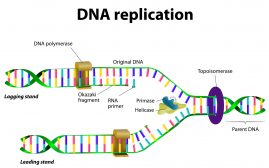Table of Contents
Definition
noun
plural: adenine nucleotides
A nucleotide wherein the nucleobase is adenine
Details
Overview
A nucleotide is an organic compound made up of three subunits: (1) a nucleobase, (2) a pentose sugar (a ribose or a deoxyribose), and (3) phosphate group. It can also be defined as a nucleoside having a phosphate unit since a nucleoside is comprised of the first two, i.e. a nucleobase and a pentose sugar. In this regard, adenine attached to a pentose sugar is referred to as adenosine.
Nucleotides are the fundamental building block of nucleic acids, DNA and RNA. There are five fundamental nucleobases that make up the monomeric nucleotides of a nucleic acid: guanine, adenine, cytosine, thymine, and uracil. Thus, adenine nucleotide refers to any of the nucleotides wherein adenine is the nucleobase.
Apart from the long chain of nucleic acids, nucleotides also occur in cyclic forms. Cyclic nucleotides form when the phosphate group is linked twice to the sugar moiety, particularly to the two hydroxyl groups of the constituent sugar.
Types
Types
Adenosine monophosphate (AMP) is a nucleoside phosphate in being comprised of a ribonucleoside and one phosphate group. It means it has a ribose as its sugar and one phosphate group attached. AMP is used as a monomer in RNA. It may also be used to regenerate adenosine triphosphate (ATP): i.e. from the chemical reaction AMP + ATP → 2 ADP then ADP + Pi → ATP. AMP may also serve as a source of inosine monophosphate (IMP). It is sometimes converted into IMP with the catalytic action of myoadenylate deaminase. AMP may also be converted into uric acid that is excreted from the body.
Types
Cyclic adenosine monophosphate (cAMP) is a cyclic form of AMP. It serves as a second messenger for signal transduction at the cellular level. In particular, it is used in transferring into cells the effects of glucagon and adrenaline. These hormones cannot pass through the plasma membrane of target cells and therefore need cAMP as a second messenger. It works by activating protein kinase A (PKA). Apart from the intracellular signal transduction, cAMP is also used for the regulation of the passage of calcium ions through ion channels. It also serves as an extracellular morphogen for some slime moulds.
Types
Adenosine diphosphate (ADP) is a nucleoside phosphate comprised of a ribonucleoside and two phosphate groups. It has two phosphate groups attached to the nucleoside. The nucleoside is a pentose sugar backbone with a purine base adenine attached to it (at the 1′ carbon). The phosphate groups are bonded in series to the 5′ carbon of the pentose sugar. ADP is essential in photosynthesis and glycolysis. It is the end-product when adenosine triphosphate ATP loses one of its phosphate groups. The energy released in the process is used to power up many vital cellular processes. ADP reconverts to ATP by the addition of a phosphate group to ADP. This occurs in processes such as substrate-level phosphorylation, oxidative phosphorylation, and photophosphorylation. ADP is also important during the activation of platelets. It is stored inside the platelet and is released to interact with ADP receptors (e.g. P2Y1 receptors, P2Y12 receptors, etc.) on platelets.
Types
Adenosine triphosphate (ATP) is a nucleoside phosphate comprised of a ribonucleoside and three phosphate groups. Its structure is comprised of a purine base, particularly adenine that is bound at the 9′ nitrogen atom to the 1′ carbon atom of ribose sugar, and a three phosphate groups.
ATP contains a large amount of chemical energy stored in its high-energy phosphate bonds. It releases energy when it is broken down (hydrolyzed) into ADP. The energy is used for many metabolic processes. Hence, ATP is considered as the universal energy currency for metabolism. Its functions are for intracellular energy transport for various metabolic processes including biosynthetic reactions, motility, and cell division.
Types
Deoxyadenosine monophosphate (dAMP) is a nucleoside phosphate in being comprised of a deoxyribonucleoside and one phosphate group. This means that it has a deoxyribose as its sugar constituent with one phosphate group attached. Its conjugate acid form is deoxyadenylic acid whereas its conjugate base form is deoxyadenylate. dAMP may serve as one of the monomer nucleotides in DNA when it is phosphorylated with two more phosphate groups, thus becoming dATP (deoxyadenosine triphosphate). In DNA, dATP complementary base pairs with (deoxy)thymidine triphosphate (dTTP).
Types
Deoxyadenosine diphosphate (dADP) is a nucleoside phosphate in being comprised of a deoxyribonucleoside and two phosphate units. Its nucleoside contains a purine base, i.e. an adenine attached to the ribose sugar. dADP is a metabolite. It has a role in purine metabolism. It is present in the mitochondria and the nucleus of certain cells.
Types
Deoxyadenosine triphosphate (dATP) is a nucleoside phosphate in being comprised of a deoxyribonucleoside and three phosphate units. Its nucleoside contains a purine base, i.e. an adenine attached to the ribose sugar. dATP is one of the monomeric nucleotides that make up DNA. The others are deoxyribocytidine triphosphate (dCTP), deoxyguanosine triphosphate (dGTP), and (deoxy)thymidine triphosphate (dTTP). In DNA, dATP complementary base pairs with dTTP. During transcription (mRNA synthesis), dATP complementary base pairs with uracil nucleotide.
Common biological reactions
Common biological reactions
Adenine nucleotide comes from the nucleotide inosine monophosphate (IMP). Purines, such as adenine, are synthesized as ribonucleotides and not as free nucleobases. IMP, in turn, is produced from a pre-existing ribose phosphate that forms mainly from the amino acids glycine, glutamine, and aspartic acid. Ribose 5-phosphate reacts with ATP to produce 5-Phosphoribosyl-1-pyrophosphate (PRPP).
Further reading
See also
- adenine
- nucleotide
- adenosine
© Biology Online. Content provided and moderated by Biology Online Editors



